 Actor Timothy Dalton had been considered for the role of James Bond several times before, in fact producer Albert ‘Cubby’ Broccoli first approached him in 1968 for On Her Majesty’s Secret Service (1969), but Dalton refused declaring he was too young for the role: “Originally I did not want to take over from Sean Connery. He was far too good, he was wonderful. I was about 24 or 25, which is too young, but when you’ve seen Bond from the beginning, you don’t take over from Sean Connery.”
Actor Timothy Dalton had been considered for the role of James Bond several times before, in fact producer Albert ‘Cubby’ Broccoli first approached him in 1968 for On Her Majesty’s Secret Service (1969), but Dalton refused declaring he was too young for the role: “Originally I did not want to take over from Sean Connery. He was far too good, he was wonderful. I was about 24 or 25, which is too young, but when you’ve seen Bond from the beginning, you don’t take over from Sean Connery.”
Dalton was approached again in 1979, but didn’t like the comedic direction the films were taking at that time, nor did he think the producers were seriously looking for a new 007. In a 1979 episode of the television series Charlie’s Angels, Dalton played the role of Damien Roth, a Bond-like millionaire playboy and, in 1986, Dalton was approached again to play Bond after Roger Moore had retired and Pierce Brosnan was still tied to the television series Remington Steele. Dalton agreed to star in The Living Daylights (1987) as soon as filming on Brenda Starr Reporter (1989) was completed.
Also read: A Brief History Of Bond, James Bond (1962-1985)
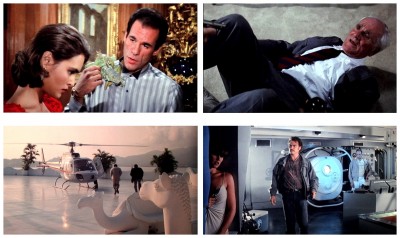 The Living Daylights (1987) was the fifteenth Bond film and the first to star Timothy Dalton as the fictional MI6 agent 007. The title is taken from one of author Ian Fleming’s short stories, and was the last film to use a Fleming title until Casino Royale (2006) rebooted the franchise. The beginning of the film resembles the short story, in which Bond is assigned to protect a Soviet defector named Koskov (Jeroen Krabbe), who tells Bond that KGB head Pushkin (John Rhys-Davies) is systematically killing off British and American agents. When Koskov is snatched back by the Soviets, Bond follows him across Europe, Morocco and Afghanistan. Bond leaps into action following a trail that leads to the gorgeous musician Kara (Maryam d’Abo), who manipulates Bond as easily as she plays her cello. As they unravel a complex weapons scheme with global implications, they are forced into hair-raising chases, a riveting jailbreak and an epic battle in the Afghanistan desert with tanks, airplanes and a legion of freedom fighters on horseback. Produced by Cubby Broccoli, his daughter Barbara Boccoli and his stepson Michael G. Wilson, The Living Daylights was well received and declared a financial success, grossing almost US$200 million worldwide.
The Living Daylights (1987) was the fifteenth Bond film and the first to star Timothy Dalton as the fictional MI6 agent 007. The title is taken from one of author Ian Fleming’s short stories, and was the last film to use a Fleming title until Casino Royale (2006) rebooted the franchise. The beginning of the film resembles the short story, in which Bond is assigned to protect a Soviet defector named Koskov (Jeroen Krabbe), who tells Bond that KGB head Pushkin (John Rhys-Davies) is systematically killing off British and American agents. When Koskov is snatched back by the Soviets, Bond follows him across Europe, Morocco and Afghanistan. Bond leaps into action following a trail that leads to the gorgeous musician Kara (Maryam d’Abo), who manipulates Bond as easily as she plays her cello. As they unravel a complex weapons scheme with global implications, they are forced into hair-raising chases, a riveting jailbreak and an epic battle in the Afghanistan desert with tanks, airplanes and a legion of freedom fighters on horseback. Produced by Cubby Broccoli, his daughter Barbara Boccoli and his stepson Michael G. Wilson, The Living Daylights was well received and declared a financial success, grossing almost US$200 million worldwide.
 Licence To Kill (1989) was Bond number sixteen, the fifth to be directed by John Glen and the second (and final) outing for Timothy Dalton. The story combines two of Fleming’s stories mixed with aspects taken from original Japanese Ronin tales, in which Bond and his old friend Felix Leiter (David Hedison) apprehend an infamous drug lord named Sanchez (Robert Davi), who eventually escapes in order to kidnap Felix and his new bride. When Bond learns of this he goes after Sanchez, but when ‘M’ (Robert Brown) learns of this he has Bond’s license to kill revoked. Bond meets Pam Bouvier (Carey Lowell), one of Felix’s assistants, and hires her to get him to into Sanchez’s country. Bond befriends Sanchez with the pretense of looking for work, and he eventually trusts Bond enough to allow him to enter the inner circle of Sanchez’s drug empire. Due to the relatively small budget, Licence To Kill was the first Bond film not to be shot in the United Kingdom, and was made on location in Florida and Mexico instead.
Licence To Kill (1989) was Bond number sixteen, the fifth to be directed by John Glen and the second (and final) outing for Timothy Dalton. The story combines two of Fleming’s stories mixed with aspects taken from original Japanese Ronin tales, in which Bond and his old friend Felix Leiter (David Hedison) apprehend an infamous drug lord named Sanchez (Robert Davi), who eventually escapes in order to kidnap Felix and his new bride. When Bond learns of this he goes after Sanchez, but when ‘M’ (Robert Brown) learns of this he has Bond’s license to kill revoked. Bond meets Pam Bouvier (Carey Lowell), one of Felix’s assistants, and hires her to get him to into Sanchez’s country. Bond befriends Sanchez with the pretense of looking for work, and he eventually trusts Bond enough to allow him to enter the inner circle of Sanchez’s drug empire. Due to the relatively small budget, Licence To Kill was the first Bond film not to be shot in the United Kingdom, and was made on location in Florida and Mexico instead.
It earned more than US$150 million and enjoyed a generally positive reception with much praise for the stunts, but there was some criticism concerning Dalton’s politically correct interpretation and that the film was too dark and more violent than its predecessors (there’s just no pleasing some people). Following the release of the film there was a great deal of legal wrangling over the control of the Bond character resulting in six years delay in production of the next film which is why Dalton decided not to return. It was also the final Bond film for actors Robert Brown and Caroline Bliss (as Miss Moneypenny), screenwriter Richard Maibaum, titles designer Maurice Binder, editor John Grover, cinematographer Alec Mills, director John Glen, as well as the original instigator and producer of the franchise, Cubby Broccoli.
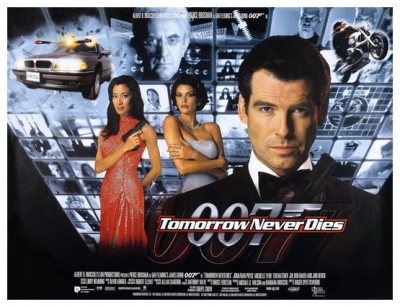 The relatively disappointing returns for Licence To Kill (1989) led to Cubby Broccoli questioning his own leadership of the series, and put the Bond copyright up for sale. Timothy Dalton said, “My feeling is this will be the last one. I don’t mean my last one, I mean the end of the whole lot. I don’t speak with any real authority, but it’s sort of a feeling I have.” In 1990 the situation was further complicated when MGM/UA was sold to Qinex which merged with Pathé who leased out the Bond back-catalogue at a lower-than-market value. Cubby Broccoli proceeded to sue MGM/UA and appointed his daughter Barbara and stepson Michael in charge of the franchise. The entire dispute was rather protracted and delayed production of the seventeenth Bond film, but was finally settled in 1993. The new producers changed the policy of behind-the-scenes continuity prevalent in the series up to that point and there were more changes in key production roles, intending to hire future ‘guest’ directors for each new film.
The relatively disappointing returns for Licence To Kill (1989) led to Cubby Broccoli questioning his own leadership of the series, and put the Bond copyright up for sale. Timothy Dalton said, “My feeling is this will be the last one. I don’t mean my last one, I mean the end of the whole lot. I don’t speak with any real authority, but it’s sort of a feeling I have.” In 1990 the situation was further complicated when MGM/UA was sold to Qinex which merged with Pathé who leased out the Bond back-catalogue at a lower-than-market value. Cubby Broccoli proceeded to sue MGM/UA and appointed his daughter Barbara and stepson Michael in charge of the franchise. The entire dispute was rather protracted and delayed production of the seventeenth Bond film, but was finally settled in 1993. The new producers changed the policy of behind-the-scenes continuity prevalent in the series up to that point and there were more changes in key production roles, intending to hire future ‘guest’ directors for each new film.
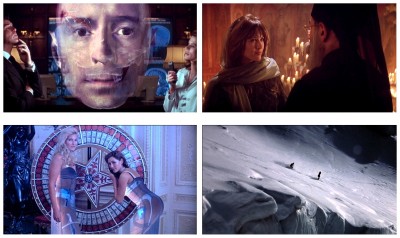 Despite all these legal hassles, pre-production towards GoldenEye (1995) still progressed, with details being revealed as early as 1990 at the Cannes Film Festival. Screenwriter Michael France started working on a script while producers approached Anthony Hopkins to play the intended villain. Dalton’s six-year contract expired in 1993 and announced in 1994 that he would not return to play Bond, which gave Pierce Brosnan a chance to step into the role. The film starts in 1986 when 007 and his closest compatriot, 006 (Sean Bean), infiltrate a Soviet Russian chemical weapons plant. 006 is captured and shot by General Ouromov (Gottfried John) while Bond makes a spectacular escape and succeeds in blowing up the compound. Fast-forward to 1995, Bond is assigned to find Soviet jet pilot Xenia Onatopp (Famke Janssen) who is working for a Russian crime syndicate known as Janus.
Despite all these legal hassles, pre-production towards GoldenEye (1995) still progressed, with details being revealed as early as 1990 at the Cannes Film Festival. Screenwriter Michael France started working on a script while producers approached Anthony Hopkins to play the intended villain. Dalton’s six-year contract expired in 1993 and announced in 1994 that he would not return to play Bond, which gave Pierce Brosnan a chance to step into the role. The film starts in 1986 when 007 and his closest compatriot, 006 (Sean Bean), infiltrate a Soviet Russian chemical weapons plant. 006 is captured and shot by General Ouromov (Gottfried John) while Bond makes a spectacular escape and succeeds in blowing up the compound. Fast-forward to 1995, Bond is assigned to find Soviet jet pilot Xenia Onatopp (Famke Janssen) who is working for a Russian crime syndicate known as Janus.
She steals a powerful experimental helicopter gunship and the new ‘M’ (Judi Dench) is forced to trust Bond’s instincts after a nuclear accident occurs over a Russian region housing the tracking station for a weapons satellite known as GoldenEye. Bond tracks down the stolen gunship which leads to the discovery of a second GoldenEye system and the true identity of the Janus syndicate, which leads to a spectacular running pursuit from the stolen gunship through a Soviet army prison to a wild street chase involving a tank and confrontation with a Soviet missile train, eventually leading to a showdown in the jungles of Cuba.
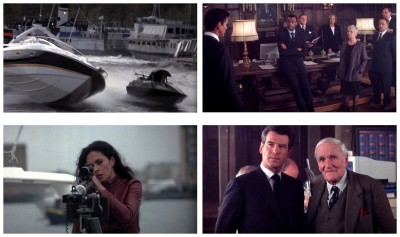 The first-draft script of GoldenEye (1995) by Michael France was rewritten by Jeffrey Caine, Kevin Wade and Bruce Feirstein, and vintage martial arts director John Woo was approached to direct the film, but turned it down saying he was extremely honoured by the offer, so the producers hired New Zealander Martin Campbell to helm the project instead. For the scenes of Severnaya and other effects, model-maker Derek Meddings built a number of miniature sets at Leavesden. Meddings had worked on every Bond film since Live And Let Die (1973) and sadly passed away before the film’s release, which is why GoldenEye is dedicated to his memory. Prolific Bond composer John Barry chose not to score the film, so the soundtrack was written and performed by Luc Besson‘s favourite composer Eric Serra, with the title song written by U2 and performed by Tina Turner. In fact, the producers had so much confidence in the final product that they started preproduction on Tomorrow Never Dies (1997) before GoldenEye was even released.
The first-draft script of GoldenEye (1995) by Michael France was rewritten by Jeffrey Caine, Kevin Wade and Bruce Feirstein, and vintage martial arts director John Woo was approached to direct the film, but turned it down saying he was extremely honoured by the offer, so the producers hired New Zealander Martin Campbell to helm the project instead. For the scenes of Severnaya and other effects, model-maker Derek Meddings built a number of miniature sets at Leavesden. Meddings had worked on every Bond film since Live And Let Die (1973) and sadly passed away before the film’s release, which is why GoldenEye is dedicated to his memory. Prolific Bond composer John Barry chose not to score the film, so the soundtrack was written and performed by Luc Besson‘s favourite composer Eric Serra, with the title song written by U2 and performed by Tina Turner. In fact, the producers had so much confidence in the final product that they started preproduction on Tomorrow Never Dies (1997) before GoldenEye was even released.
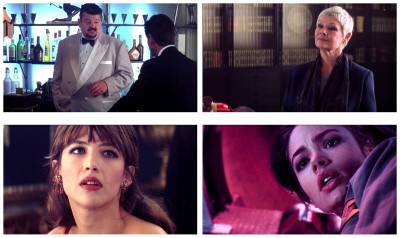 The producers were unable to convince director Martin Campbell to return for Tomorrow Never Dies (1997), refusing to do two Bond films in a row, so Roger Spottiswoode, director of Turner And Hooch (1989) and Air America (1990), was chosen to helm the project. The story was based on a previously discarded script by Donald E. Westlake thoroughly rewritten by Bruce Feirstein, Nicholas Meyer, Dan Petrie Junior and David Campbell Wilson. When a British warship is mysteriously destroyed in Chinese waters, the world teeters on the brink of World War Three, until 007 is assigned to find the true criminal mastermind.
The producers were unable to convince director Martin Campbell to return for Tomorrow Never Dies (1997), refusing to do two Bond films in a row, so Roger Spottiswoode, director of Turner And Hooch (1989) and Air America (1990), was chosen to helm the project. The story was based on a previously discarded script by Donald E. Westlake thoroughly rewritten by Bruce Feirstein, Nicholas Meyer, Dan Petrie Junior and David Campbell Wilson. When a British warship is mysteriously destroyed in Chinese waters, the world teeters on the brink of World War Three, until 007 is assigned to find the true criminal mastermind.
His mission leads him to Elliot Carver (Jonathan Price), the world’s most powerful media mogul who manipulates global events as easily as he changes newspaper headlines. After soliciting help from Carver’s sexy wife Paris (Teri Hatcher), Bond joins forces with the stunning yet lethal Chinese agent Wai Lin (Michelle Yeoh) in a series of explosive chases, brutal confrontations and breathtaking escapes as they race to stop the presses on Carver’s next planned news story – global war! Leavesden Studios was unavailable and Pinewood Studios was no longer large enough, so the producers converted an abandoned warehouse in Hertfordshire into a film studio. Filming went three weeks overtime, and the delays in the production process and the rush to deliver the film by the deadline drove the budget up to US$110 million. Fortunately, Tomorrow Never Dies opened to generally positive reviews and took US$340 million at the box-office.
 Barbara Broccoli was rather impressed by Peter Jackson‘s work on Heavenly Creatures (1994) and considered hiring him to direct The World Is Not Enough (1999), until she saw his following film The Frighteners (1996) and dropped him like a hot rock. Instead Michael Apted – famous for Coal Miner’s Daughter (1980) and Gorillas In The Mist (1988) – was hired to direct a script by Neal Purvis and Robert Wade. Apted and his wife Dana Stevens rewrote the script, but Pierce Brosnan was so unhappy with their changes that Michael G. Wilson and Bruce Feirstein undertook another revision. Production was based at Pinewood Studios and principal photography began in 1999 with scenes inside the MI6 offices designed by Peter Lamont, and David Arnold returned to score the music while Garbage wrote and performed the title song.
Barbara Broccoli was rather impressed by Peter Jackson‘s work on Heavenly Creatures (1994) and considered hiring him to direct The World Is Not Enough (1999), until she saw his following film The Frighteners (1996) and dropped him like a hot rock. Instead Michael Apted – famous for Coal Miner’s Daughter (1980) and Gorillas In The Mist (1988) – was hired to direct a script by Neal Purvis and Robert Wade. Apted and his wife Dana Stevens rewrote the script, but Pierce Brosnan was so unhappy with their changes that Michael G. Wilson and Bruce Feirstein undertook another revision. Production was based at Pinewood Studios and principal photography began in 1999 with scenes inside the MI6 offices designed by Peter Lamont, and David Arnold returned to score the music while Garbage wrote and performed the title song.
The nineteenth Bond film follows 007 to a Swiss bank in Spain to retrieve three million pounds but finds himself in the middle of a siege. Bond barely escapes with the suitcase of money and returns to MI6 for debriefing where he is introduced to industrialist Sir Robert King (David Calder). The suitcase is actually a bomb which destroys the MI6 headquarters killing Sir Robert, and eventually meets Sir Robert’s daughter Electra (Sophie Marceau), who has inherited her father’s oil company. Bond is assigned to put a stop to a new enemy by the name of Renard (Robert Carlyle), a man who feels absolutely no pain due to a bullet lodged in his brain. Renard and Electra plan to destroy half of Europe with weapons of mass destruction so Bond, with the help of research scientist Christmas Jones (Denise Richards), must foil the terrorist plan before the Continent is irreparably damaged. The title The World Is Not Enough was taken from Ernst Blofeld’s coat of arms in On Her Majesty’s Secret Service (1969).
 Come time to start work on Bond’s twentieth outing, the producers started looking for the next ‘guest director’ to helm Die Another Day (2002). The New Zealand film Once Were Warriors (1994) directed by Lee Tamahori was described by Barbara Broccoli as a phenomenal piece of filmmaking, saying that both she and Michael G. Wilson were very impressed with Tamahori’s genuine enthusiasm for the James Bond character and felt quite lucky to get him. Screenwriters Neal Purvis and Robert Wade utilised the premise of Ian Fleming‘s novel Moonraker, that of an industrialist super-villain with two identities. With the planned release of the twentieth film on the fortieth anniversary of the franchise, Tamahori named the Hong Kong hotel seen in the film the ‘Rubyeon Royale’ in honour of Eon Production’s ruby anniversary as well as Fleming’s first novel, Casino Royale. This time around Bond is assigned to investigate a terrorist by the name of Zao (Rick Yune) and meets with North Korean Colonel Moon (Will Yun Lee) but the mission is betrayed. Despite a spectacular escape attempt, 007 is captured and subjected to vicious torture before being released in an exchange of prisoners. Bond is nursed back to full health but is accused of leaking information while in custody, leading to the deaths of a number of agents.
Come time to start work on Bond’s twentieth outing, the producers started looking for the next ‘guest director’ to helm Die Another Day (2002). The New Zealand film Once Were Warriors (1994) directed by Lee Tamahori was described by Barbara Broccoli as a phenomenal piece of filmmaking, saying that both she and Michael G. Wilson were very impressed with Tamahori’s genuine enthusiasm for the James Bond character and felt quite lucky to get him. Screenwriters Neal Purvis and Robert Wade utilised the premise of Ian Fleming‘s novel Moonraker, that of an industrialist super-villain with two identities. With the planned release of the twentieth film on the fortieth anniversary of the franchise, Tamahori named the Hong Kong hotel seen in the film the ‘Rubyeon Royale’ in honour of Eon Production’s ruby anniversary as well as Fleming’s first novel, Casino Royale. This time around Bond is assigned to investigate a terrorist by the name of Zao (Rick Yune) and meets with North Korean Colonel Moon (Will Yun Lee) but the mission is betrayed. Despite a spectacular escape attempt, 007 is captured and subjected to vicious torture before being released in an exchange of prisoners. Bond is nursed back to full health but is accused of leaking information while in custody, leading to the deaths of a number of agents.
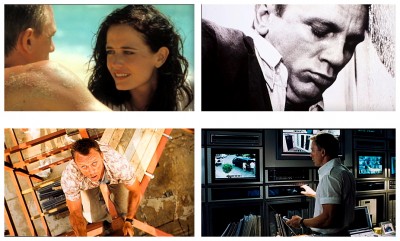 Determined to clear his name and avenge himself on Zao, Bond extracts information from a known Chinese intelligence officer, leading to Cuba and a meeting with a mysterious diver known only as Jinx (Halle Berry). He also meets with a mysterious British billionaire named Gustav Graves (Toby Stephens), who has perfected a space-mirror designed to beam solar light and heat to anywhere in the world for peaceful purposes. Bond uncovers mysterious genetic conversion equipment and discovers the solar mirror is in reality a laser cannon that can destroy almost anything on Earth. Now he has to rescue Jinx (who is conducting her own investigation of Graves) and learn the truth about the laser cannon, which leads to a violent showdown as the weapon is fired and begins slicing open a gigantic line of destruction. The soundtrack was composed by David Arnold again, while the title song was written and performed by Madonna, who makes a cameo appearance as a fencing instructor. With a budget of US$142 million, Die Another Day (2002) was declared a success earning almost US$440 million at the box-office.
Determined to clear his name and avenge himself on Zao, Bond extracts information from a known Chinese intelligence officer, leading to Cuba and a meeting with a mysterious diver known only as Jinx (Halle Berry). He also meets with a mysterious British billionaire named Gustav Graves (Toby Stephens), who has perfected a space-mirror designed to beam solar light and heat to anywhere in the world for peaceful purposes. Bond uncovers mysterious genetic conversion equipment and discovers the solar mirror is in reality a laser cannon that can destroy almost anything on Earth. Now he has to rescue Jinx (who is conducting her own investigation of Graves) and learn the truth about the laser cannon, which leads to a violent showdown as the weapon is fired and begins slicing open a gigantic line of destruction. The soundtrack was composed by David Arnold again, while the title song was written and performed by Madonna, who makes a cameo appearance as a fencing instructor. With a budget of US$142 million, Die Another Day (2002) was declared a success earning almost US$440 million at the box-office.
 MGM/UA obtained the rights to Casino Royale (1967) from Sony Pictures for US$10 million in an out-of-court settlement of a law suit. The case came about after Sony had announced a deal with Kevin McClory to produce a third version of Thunderball for which he held the film rights. McClory had previously acted as producer on Thunderball (1965) and had licensed his rights for the production of Never Say Never Again (1983). Due to severe financial troubles, MGM/UA was purchased by Sony for US$5 billion in 2002 and, after forty years, the Broccolis finally had access to the title of Ian Fleming‘s first Bond novel. Barbara Broccoli said, “For years my father wanted to make Casino Royale – it’s the Holy Grail – we wanted to make a tougher film, the way it should have been made years ago.” Producer Michael G. Wilson agreed: “We felt the last film was too fantastical, so we decided to go back to the basics and update.” Casino Royale (2005) was intended to reboot the franchise with a new actor in the lead, establishing a new timeline and narrative framework unconnected to any other Bond film. Martin Campbell, director of GoldenEye (1995), was brought in to helm the project, although the identity of the new Bond was still unknown. The producers chose not to renew Pierce Brosnan‘s contract and announced that the part of Bond would be taken by Daniel Craig.
MGM/UA obtained the rights to Casino Royale (1967) from Sony Pictures for US$10 million in an out-of-court settlement of a law suit. The case came about after Sony had announced a deal with Kevin McClory to produce a third version of Thunderball for which he held the film rights. McClory had previously acted as producer on Thunderball (1965) and had licensed his rights for the production of Never Say Never Again (1983). Due to severe financial troubles, MGM/UA was purchased by Sony for US$5 billion in 2002 and, after forty years, the Broccolis finally had access to the title of Ian Fleming‘s first Bond novel. Barbara Broccoli said, “For years my father wanted to make Casino Royale – it’s the Holy Grail – we wanted to make a tougher film, the way it should have been made years ago.” Producer Michael G. Wilson agreed: “We felt the last film was too fantastical, so we decided to go back to the basics and update.” Casino Royale (2005) was intended to reboot the franchise with a new actor in the lead, establishing a new timeline and narrative framework unconnected to any other Bond film. Martin Campbell, director of GoldenEye (1995), was brought in to helm the project, although the identity of the new Bond was still unknown. The producers chose not to renew Pierce Brosnan‘s contract and announced that the part of Bond would be taken by Daniel Craig.
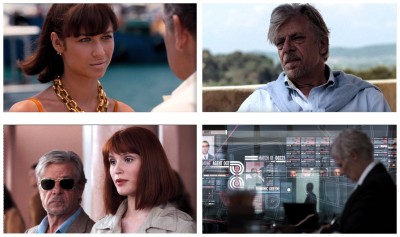 Casino Royale (2005) introduces Bond before he attains his license to kill, but he is no less dangerous and, with two professional assassinations in quick succession, he is elevated to ’00’ status. His first mission as 007 takes him to Uganda where investigates a terrorist named Mollaka (Sebastian Foucan), but not everything goes to plan and Bond decides to track down the rest of the terrorist cell. Following a lead to the Bahamas, he encounters Dimitrios (Simon Abkarian) and his wife Solange (Caterina Murino), and learns that Dimitrios is involved with Le Chiffre (Mads Mikkelson), banker to terrorist organisations worldwide. Le Chiffre plans to raise money in a high-stakes poker game at Casino Royale in Montenegro, and MI6 assigns 007 to play against him, knowing that if Le Chiffre loses it will destroy his organisation. ‘M’ (Judi Dench) also assigns the beguiling Vesper Lynd (Eva Green) to watch over Bond, whose interest in her deepens as they bravely face danger and torture together at the hands of Le Chiffre. While in Montenegro Bond allies himself with MI6 agent Mathis (Giancarlo Giannini) and CIA agent Felix Leiter (Jeffrey Wright), and the marathon poker game proceeds with dirty tricks and violence, raising the stakes beyond blood money until reaching a terrifying climax.
Casino Royale (2005) introduces Bond before he attains his license to kill, but he is no less dangerous and, with two professional assassinations in quick succession, he is elevated to ’00’ status. His first mission as 007 takes him to Uganda where investigates a terrorist named Mollaka (Sebastian Foucan), but not everything goes to plan and Bond decides to track down the rest of the terrorist cell. Following a lead to the Bahamas, he encounters Dimitrios (Simon Abkarian) and his wife Solange (Caterina Murino), and learns that Dimitrios is involved with Le Chiffre (Mads Mikkelson), banker to terrorist organisations worldwide. Le Chiffre plans to raise money in a high-stakes poker game at Casino Royale in Montenegro, and MI6 assigns 007 to play against him, knowing that if Le Chiffre loses it will destroy his organisation. ‘M’ (Judi Dench) also assigns the beguiling Vesper Lynd (Eva Green) to watch over Bond, whose interest in her deepens as they bravely face danger and torture together at the hands of Le Chiffre. While in Montenegro Bond allies himself with MI6 agent Mathis (Giancarlo Giannini) and CIA agent Felix Leiter (Jeffrey Wright), and the marathon poker game proceeds with dirty tricks and violence, raising the stakes beyond blood money until reaching a terrifying climax.
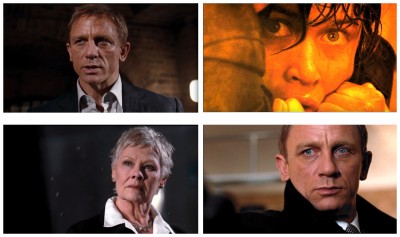 Screenwriters Neal Purvis and Robert Wade were brought in again to assemble the script, and Paul Haggis was hired for rewrites, his main contribution being the climax of the film: “The draft that was there was very faithful to the book and there was a confession, so in the original draft the character confessed and killed herself. She then sent Bond to chase after the villains – Bond chased the villains into the house. I don’t know why but I thought that Vesper had to be in the sinking house and Bond has to want to kill her and then try and save her.” For many of the special effects in the film, supervisor Chris Corbould significantly reduced the digital effects in favour of a more realistic style of filmmaking: “CGI is a great tool and can be very useful, but I will fight to the tooth and nail to do something for real. It’s the best way to go.” Casino Royale (2005) features music composed by David Arnold, his fourth soundtrack for the franchise, and the theme song You Know My Name was co-written and performed by Chris Cornell.
Screenwriters Neal Purvis and Robert Wade were brought in again to assemble the script, and Paul Haggis was hired for rewrites, his main contribution being the climax of the film: “The draft that was there was very faithful to the book and there was a confession, so in the original draft the character confessed and killed herself. She then sent Bond to chase after the villains – Bond chased the villains into the house. I don’t know why but I thought that Vesper had to be in the sinking house and Bond has to want to kill her and then try and save her.” For many of the special effects in the film, supervisor Chris Corbould significantly reduced the digital effects in favour of a more realistic style of filmmaking: “CGI is a great tool and can be very useful, but I will fight to the tooth and nail to do something for real. It’s the best way to go.” Casino Royale (2005) features music composed by David Arnold, his fourth soundtrack for the franchise, and the theme song You Know My Name was co-written and performed by Chris Cornell.
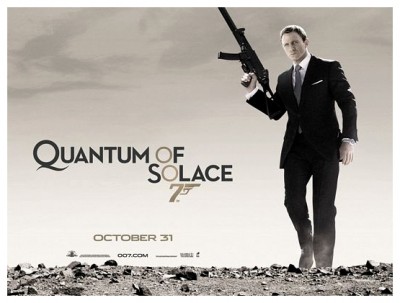 As Casino Royale (2005) entered post-production, Barbara Broccoli announced that the next film would be based on an original idea by producer Michael G. Wilson entitled Quantum Of Solace (2008) and that Marc Forster was confirmed as the next ‘guest director’. Forster was frankly surprised that he was approached for the job, stating he was never really a fan of the films and that he would’ve refused the position had he not seen Casino Royale (2005) prior to making his decision. He felt Bond had been greatly humanised in that film and, since traveling the world had become less exotic, it made sense to focus more on the character of Bond. Furthermore, he declared Casino Royale was way too long at 144 minutes and wanted his follow-up to be “Tight and fast like a bullet.” ‘M’ (Judi Dench) assigns Bond to investigate a shadowy international network of power and corruption reaping billions of dollars. An assassination attempt on ‘M’ inspires 007 to pursue the agents responsible, which leads to Dominic Greene (Mathieu Amalric), a famous developer of green technology. A rather nasty piece of work, Greene is intent on securing a barren area of Bolivia in exchange for assisting a coup there. The CIA looks the other way and only Bond – with the assistance of a retired spy and a mysterious beauty – stands in Greene’s way. ‘M’ wonders if she can trust 007 or if vengeance will possess him.
As Casino Royale (2005) entered post-production, Barbara Broccoli announced that the next film would be based on an original idea by producer Michael G. Wilson entitled Quantum Of Solace (2008) and that Marc Forster was confirmed as the next ‘guest director’. Forster was frankly surprised that he was approached for the job, stating he was never really a fan of the films and that he would’ve refused the position had he not seen Casino Royale (2005) prior to making his decision. He felt Bond had been greatly humanised in that film and, since traveling the world had become less exotic, it made sense to focus more on the character of Bond. Furthermore, he declared Casino Royale was way too long at 144 minutes and wanted his follow-up to be “Tight and fast like a bullet.” ‘M’ (Judi Dench) assigns Bond to investigate a shadowy international network of power and corruption reaping billions of dollars. An assassination attempt on ‘M’ inspires 007 to pursue the agents responsible, which leads to Dominic Greene (Mathieu Amalric), a famous developer of green technology. A rather nasty piece of work, Greene is intent on securing a barren area of Bolivia in exchange for assisting a coup there. The CIA looks the other way and only Bond – with the assistance of a retired spy and a mysterious beauty – stands in Greene’s way. ‘M’ wonders if she can trust 007 or if vengeance will possess him.
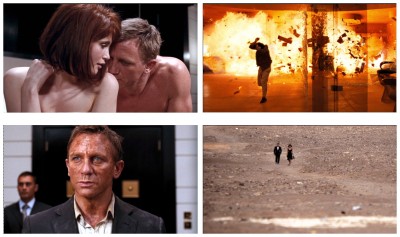 Neal Purvis and Robert Wade returned as screenwriters and completed a first draft, rewritten by Paul Haggis, completing it exactly two hours before the Writers Guild Of America went on strike. Any further work on the script had to be undertaken by Forster and Daniel Craig, who said, “We had the bare-bones of a script and then there was a writers strike and there was nothing we could do. We couldn’t employ a writer to finish it. I say to myself, ‘Never again’ but who knows? There was me trying to rewrite scenes, and a writer I am not.” Craig also admitted that the film was not initially meant to be a sequel, but it became one because of the rewrites undertaken by him and Forster. The original script had the climax take place in the Swiss Alps, but Forster insisted the action sequences to take place around the four traditional elements: earth; air; fire; water. Another big change made by Forster was hiring production designer Dennis Glassner instead of Bond regular Peter Lamont. David Arnold, who composed the scores for the previous four Bond films, returned for Quantum Of Solace (2008), saying that Forster likes to work very closely with his composers. Compared to the tight deadlines he usually received, Arnold was allowed to spend more time scoring the film, enabling him to experiment a little more with the soundtrack, including the theme song co-written and performed by Jack White and Alicia Keys, the first Bond theme to feature a duet.
Neal Purvis and Robert Wade returned as screenwriters and completed a first draft, rewritten by Paul Haggis, completing it exactly two hours before the Writers Guild Of America went on strike. Any further work on the script had to be undertaken by Forster and Daniel Craig, who said, “We had the bare-bones of a script and then there was a writers strike and there was nothing we could do. We couldn’t employ a writer to finish it. I say to myself, ‘Never again’ but who knows? There was me trying to rewrite scenes, and a writer I am not.” Craig also admitted that the film was not initially meant to be a sequel, but it became one because of the rewrites undertaken by him and Forster. The original script had the climax take place in the Swiss Alps, but Forster insisted the action sequences to take place around the four traditional elements: earth; air; fire; water. Another big change made by Forster was hiring production designer Dennis Glassner instead of Bond regular Peter Lamont. David Arnold, who composed the scores for the previous four Bond films, returned for Quantum Of Solace (2008), saying that Forster likes to work very closely with his composers. Compared to the tight deadlines he usually received, Arnold was allowed to spend more time scoring the film, enabling him to experiment a little more with the soundtrack, including the theme song co-written and performed by Jack White and Alicia Keys, the first Bond theme to feature a duet.
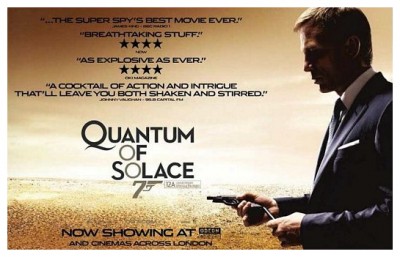 Albert ‘Cubby’ Broccoli knew he was onto something when he decided to dedicate his career to the James Bond franchise. When Doctor No (1962) starring relatively unknown Scottish actor Sean Connery was released, no-one could have guessed that, like The Rolling Stones and The Queen, 007 would still be going strong as a family business, fifty years and more than US$12 billion later. The sixth incarnation of the British intelligence agent, Ian Fleming‘s glamorously amoral spy, has been hailed as the best Bond since (and along with) Connery, and the golden anniversary movie Skyfall (2012) as a great 007 offering which has raked in more at the box-office than any of its predecessors. Unfortunately, whenever a movie press release says such a thing, they rarely take into account the fact that cinema prices have never been higher. Cubby’s daughter Barbara Broccoli inherited the franchise, and Daniel Craig is her Bond – but she had to fight for him. Initially she was outvoted by co-producer Michael G. Wilson, Sony Pictures executive Amy Pascal and Casino Royale (2005) director Martin Campbell, and Craig would be accepted only after Hugh Jackman, Clive Owen and Rikki Lee Travolta had turned down the role. Blonde and of average height, rugged and slightly jug-eared, Craig was far from the tall, dark and handsome stereotype conveyed by the increasingly high-budget gadget-driven franchise. Collecting a BAFTA award for his outing in Casino Royale which brought Bond back home as MI6’s loose cannon to be wheeled out during national emergencies.
Albert ‘Cubby’ Broccoli knew he was onto something when he decided to dedicate his career to the James Bond franchise. When Doctor No (1962) starring relatively unknown Scottish actor Sean Connery was released, no-one could have guessed that, like The Rolling Stones and The Queen, 007 would still be going strong as a family business, fifty years and more than US$12 billion later. The sixth incarnation of the British intelligence agent, Ian Fleming‘s glamorously amoral spy, has been hailed as the best Bond since (and along with) Connery, and the golden anniversary movie Skyfall (2012) as a great 007 offering which has raked in more at the box-office than any of its predecessors. Unfortunately, whenever a movie press release says such a thing, they rarely take into account the fact that cinema prices have never been higher. Cubby’s daughter Barbara Broccoli inherited the franchise, and Daniel Craig is her Bond – but she had to fight for him. Initially she was outvoted by co-producer Michael G. Wilson, Sony Pictures executive Amy Pascal and Casino Royale (2005) director Martin Campbell, and Craig would be accepted only after Hugh Jackman, Clive Owen and Rikki Lee Travolta had turned down the role. Blonde and of average height, rugged and slightly jug-eared, Craig was far from the tall, dark and handsome stereotype conveyed by the increasingly high-budget gadget-driven franchise. Collecting a BAFTA award for his outing in Casino Royale which brought Bond back home as MI6’s loose cannon to be wheeled out during national emergencies.
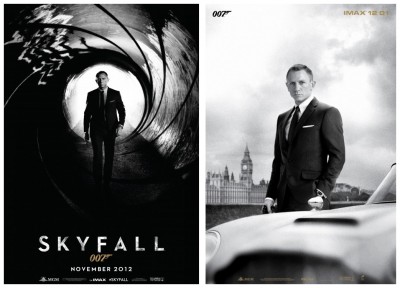 Clever, violent and only nominally on the right side, Craig has sealed his 007 eminence with Skyfall (2012). The production of the film was suspended throughout 2010 because of MGM/UA’s financial problems, then resumed preproduction following the studio’s exit from bankruptcy. Director Sam Mendes was signed onto the project shortly after Quantum Of Solace (2008) was released, and remained on board as a consultant during this period of financial uncertainty. The script was written by Bond screenwriting regulars Neal Purvis and Robert Wade assisted by John Logan, Roger Deakins signed on as cinematographer, and Dennis Gassner returned as production designer. Composer Thomas Newman – who worked with Mendes on American Beauty (1999), Road To Perdition (2002), Jarhead (2005) and Revolutionary Road (2008) – replaces David Arnold, and singer-songwriter Adele co-wrote and performs the film’s theme song. For his fiftieth anniversary outing, Bond’s mission is to keep a computer drive that has a list of British agents from being used against them. He chases the man who has it and there is an exciting brawl on the roof of a train. Eve Moneypenny (Naomie Harris), an agent sent to assist Bond, has them in her cross hairs but hesitates to take the shot because she might hit Bond but ‘M’ (Judi Dench) orders her to take the chance – she hits Bond who falls into the river and is believed to be dead. A few months later, the British government is still angered with MI6 for losing the list, specifically with ‘M’ herself. She is allowed to retire but refuses to leave until the matter is resolved. She returns to headquarters but as she arrives, there’s an explosion. In the meantime Bond, who is not dead, has been laying low. When he learns what has happened, he returns and ‘M’ tasks him with finding the one who has the information. He eventually learns that the man who has it, is someone from ‘M’s past.
Clever, violent and only nominally on the right side, Craig has sealed his 007 eminence with Skyfall (2012). The production of the film was suspended throughout 2010 because of MGM/UA’s financial problems, then resumed preproduction following the studio’s exit from bankruptcy. Director Sam Mendes was signed onto the project shortly after Quantum Of Solace (2008) was released, and remained on board as a consultant during this period of financial uncertainty. The script was written by Bond screenwriting regulars Neal Purvis and Robert Wade assisted by John Logan, Roger Deakins signed on as cinematographer, and Dennis Gassner returned as production designer. Composer Thomas Newman – who worked with Mendes on American Beauty (1999), Road To Perdition (2002), Jarhead (2005) and Revolutionary Road (2008) – replaces David Arnold, and singer-songwriter Adele co-wrote and performs the film’s theme song. For his fiftieth anniversary outing, Bond’s mission is to keep a computer drive that has a list of British agents from being used against them. He chases the man who has it and there is an exciting brawl on the roof of a train. Eve Moneypenny (Naomie Harris), an agent sent to assist Bond, has them in her cross hairs but hesitates to take the shot because she might hit Bond but ‘M’ (Judi Dench) orders her to take the chance – she hits Bond who falls into the river and is believed to be dead. A few months later, the British government is still angered with MI6 for losing the list, specifically with ‘M’ herself. She is allowed to retire but refuses to leave until the matter is resolved. She returns to headquarters but as she arrives, there’s an explosion. In the meantime Bond, who is not dead, has been laying low. When he learns what has happened, he returns and ‘M’ tasks him with finding the one who has the information. He eventually learns that the man who has it, is someone from ‘M’s past.
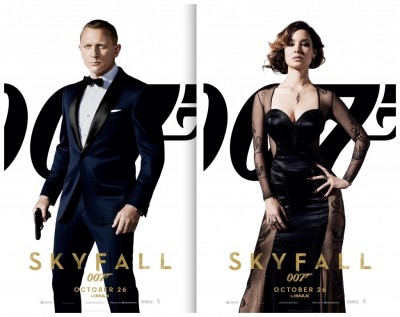 Like Casino Royale (2006), Skyfall (2012) plays to Bond’s traditions: very English; opening action sequence; exotic locales; two bad Bond girls; two good Bond girls; an Aston Martin DB5; and an exciting showdown with an unforgettable villain. Javier Bardem brings all his acting chops to stretch Craig’s own abilities, as the psychopathic cyber-terrorist Raoul Silva.
Like Casino Royale (2006), Skyfall (2012) plays to Bond’s traditions: very English; opening action sequence; exotic locales; two bad Bond girls; two good Bond girls; an Aston Martin DB5; and an exciting showdown with an unforgettable villain. Javier Bardem brings all his acting chops to stretch Craig’s own abilities, as the psychopathic cyber-terrorist Raoul Silva.
With his lisping annunciation and albino-like hair colour, he’s a menacingly seductive figure, and their encounters are laden with complex tension. In another life, Bond could have been a man like this. And that’s how Craig sees it: “The question I keep asking myself while playing the role is, am I the good guy or just the bad guy who works for the good side?” In Skyfall, with its contemporary menace and a tinge of tragedy (deaths are far more realistic than in previous films), he comes closer to Fleming’s brutal damaged antihero than Connery, whose elegance and wit remain unchallenged.
Craig’s 007 is a man for the 21st century, a tough survivalist whose flashes of humour keep him relatable. Furthermore, it looks as though he (and the franchise) are going to be around for quite a while. Like Sherlock Holmes and Batman, Bond has become a part of our culture. It’s on that rather upbeat note I’ll profusely thank the extensive special features on each of the Bond DVD releases for their kind assistance in researching this article, and ask you to please join me next week when I have the opportunity to punch your ticket for another terrifying train trip to Tinseltown. Last stop…Horror News! Toodles!
A Brief History Of Bond, James Bond (1987-2013)
 Horror News | HNN Official Site | Horror Movies,Trailers, Reviews
Horror News | HNN Official Site | Horror Movies,Trailers, Reviews


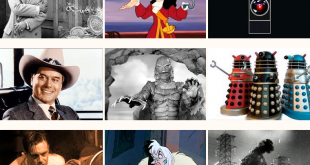
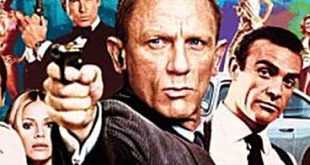
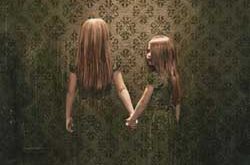
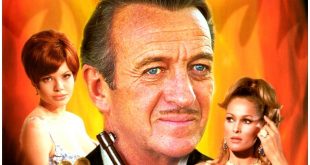
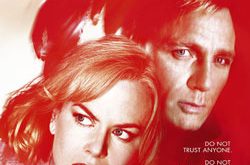
GENTELMEN;
MY WJFE 9MARY ann0 AND i9 JEFF WITT) MARE BIG ))7 jAMMES bOND FANS, WE THAT THEY WILL STILL
MAKE THESE ADVENTURE /spy films to come. WE REALLY ENJOY THEM A LOT! SEE YOU IN THE NEAR FUTURE.see you real soon1